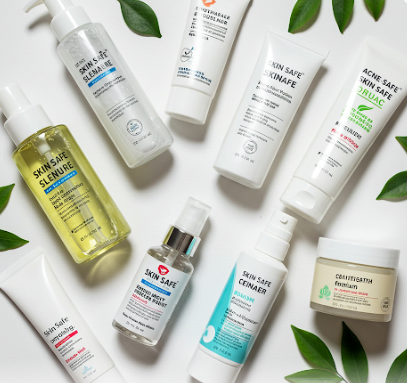Acne affects millions and choosing the right skincare products can often feel like a guessing game. Many products on the market promise to be “non-comedogenic” or “acne safe,” yet a closer look at their ingredient labels reveals that not all ingredients work for every skin type. Fortunately, modern digital tools help us get to the bottom of this mystery. One such invaluable tool is an acne ingredients checker.
What Is an Acne Ingredients Checker?
An acne ingredients checker is a digital tool that helps you review and analyze the list of ingredients in your skincare products. Instead of manually reading long labels and trying to decode confusing chemical names, you simply enter the product name or copy and paste the entire ingredient list into the tool. It then processes the information and returns a clear breakdown:
- Acne-fighting ingredients: These are ingredients with properties known to reduce inflammation, unclog pores, and keep your skin clear.
- Potential irritants or comedogenic ingredients: These are substances that may clog pores or cause irritation.
For instance, ingredients like salicylic acid, benzoyl peroxide, and retinoids are well-documented in research to help clear acne. By using an acne ingredients checker, you instantly discover which products carry proven acne-fighting ingredients and which may contain pore-clogging substances.
Why Using an Acne Ingredients Checker Matters
Choosing effective skincare becomes daunting when you have conflicting claims on product labels. Many brands use marketing buzzwords like “non-comedogenic” without standard regulation. Relying on an independent digital tool provides clarity and scientific backing.
Saving Time and Preventing Trial and Error
Instead of sifting through long lists of ingredients in search of beneficial acne-fighting ingredients, an acne ingredients checker does the heavy lifting for you. This means fewer wasted purchases and less frustration while you search for products that work for your skin type.
Building an Informed Skincare Routine
A detailed skincare product analysis allows you to:
- Identify acne-fighting ingredients: For example, salicylic acid works to unclog pores by breaking down excess sebum and dead skin cells, while retinoids promote cell turnover and reduce hyperkeratosis.
- Avoid potential irritants: Ingredients such as harsh alcohols, synthetic fragrances, and certain preservatives may cause skin irritation, even if a product is labeled as “non-comedogenic.” Studies have shown that some irritants can worsen acne by disrupting the skin barrier.
Expert Dermatologist Recommendations
Dermatologists emphasize the importance of knowing what goes into your skincare products.
“Early and consistent treatment with dermatologist-approved ingredients is key. Tools that provide clear skincare product analysis empower patients to make informed choices.”
Research-Backed Benefits
A study published in the Journal of the American Academy of Dermatology analyzed acne products advertised on Instagram. The study revealed that many of these products lacked evidence-based ingredients recommended by the AAD. The study highlighted that only a few products contained ingredients like salicylic acid and glycolic acid, which are supported by AAD guidelines. JAAD
Additionally, the AAD’s updated guidelines for acne management recommend the use of treatments containing benzoyl peroxide and topical retinoids. This emphasizes the importance of evidence-based therapies.
The Science Behind Acne-Fighting Ingredients
Understanding which ingredients work is essential to building a routine that truly helps clear acne.
Beneficial Acne-Fighting Ingredients
- Salicylic Acid:
Salicylic acid is a beta-hydroxy acid that penetrates oil-filled pores and helps dissolve the keratin that causes blockages. Research demonstrates its efficacy in reducing acne lesions. It also reduces inflammation, making it a critical component for oily skin. - Benzoyl Peroxide:
An antimicrobial agent, benzoyl peroxide kills the bacteria that cause acne (Health.com Study). While there are discussions regarding its potential degradation under high temperatures, it remains a widely used and effective ingredient in acne treatments. - Retinoids:
Retinoids and retinol derivatives promote skin cell turnover, which prevents the accumulation of dead cells that block pores. Their use is backed by decades of research, demonstrating significant improvements in acne and even offering anti-aging benefits (NCBI: Retinoids). - Niacinamide:
Niacinamide is known for its ability to reduce hyperpigmentation and improve the skin barrier function. It increases hydration and helps minimize post-acne marks, making it a vital addition to any acne regimen. - Hyaluronic Acid:
This ingredient hydrates the skin without clogging pores, ensuring that the skin remains supple and balanced. Its non-comedogenic nature makes it perfect for all skin types, especially those prone to acne.
Potential Irritants and Comedogenic Ingredients
Some ingredients can counteract the benefits of acne-fighting actives. Ingredients such as:
- Harsh Alcohols and Denatured Alcohol: These can strip the skin of its natural oils, leading to irritation and increased oil production as a compensatory response.
- Synthetic Fragrances: Even products marketed as “unscented” may contain masking fragrances that irritate sensitive skin.
- Certain Emollients and Heavy Oils: Ingredients like coconut oil, while beneficial for some, are highly comedogenic for acne-prone skin.
How to Use an Acne Ingredients Checker Effectively
Using an acne ingredients checker to build a precise skincare routine is simple. Follow these steps to optimize your purchases and routine:
Step 1: Gather the Ingredient List
Begin by locating the full ingredient list of the product you are considering. This can be found on the product packaging or on the company’s website. Copy the complete list into your clipboard.
Step 2: Input Information into the Tool
Paste the ingredient list into the designated field of your chosen checker tool. Many tools allow you to input the product name instead so they can automatically fetch the list.
Step 3: Review the Analysis
The tool will process the data and return a detailed breakdown that categorizes each ingredient as:
- Acne-fighting: Ingredients like salicylic acid and retinoids that are proven to work.
- Potential irritants or pore-clogging ingredients: These are flagged for you to avoid if you have sensitive or acne-prone skin.
Step 4: Compare Multiple Products
Often, the tool provides side-by-side comparisons so you can see which products have the cleanest, most effective ingredient profiles. This skincare product analysis enables you to decide which product best suits your specific skin needs.
Step 5: Make an Informed Purchase
Rely on the detailed results to guide your buying decisions. Choose products with a high percentage of proven acne-fighting ingredients and minimal problematic substances. This method helps save both time and money in the long run.
Steps to Use an Acne Ingredients Checker
| Step | Action | Benefit |
|---|---|---|
| 1. Gather Ingredient List | Get the full list from the product packaging or website. | Ensures no ingredient is overlooked. |
| 2. Input Information | Paste the list into the online checker tool. | Provides detailed skincare product analysis. |
| 3. Review the Results | Examine the breakdown of acne-fighting vs. irritating ingredients. | Quickly identifies which components work for you. |
| 4. Compare Products | Use side-by-side comparison features if available. | Enables better choices based on data. |
| 5. Make an Informed Purchase | Select products with mostly beneficial ingredients. | Saves time and money; improves your skin’s health. |
Research, Statistics, and Expert Opinions
Scientific studies and expert advice underpin the value of using a digital ingredient checker. Here are some key findings:
Dermatologist Insights
Top dermatologists emphasize the importance of using technology for proper ingredient analysis:
- Harold Lancer, MD, FAAD states,
“When choosing skincare products, I always insist my patients use an acne ingredients checker to quickly eliminate any pore-clogging ingredients from their routine.”
(Source: Dermatologist interview on industry forums such as Acne.org) - Dr. Sandra Lee (Dr. Pimple Popper) remarks,
“Early and consistent treatment with dermatologist-approved ingredients is key. Tools that provide clear skincare product analysis empower patients to make informed choices.”
(Source: Allure) - Karan Lal, DO, MS, FAAD, a board-certified dermatologist, explains,
“Identifying acne-fighting ingredients like salicylic acid and retinoids through proper analysis can make a huge difference in managing acne.”
(Source: Expert commentary available on several industry platforms)
Choosing the Right Skincare Products Based on Ingredient Analysis
With access to robust skincare product analysis, you can confidently navigate the array of products available. Here are a few key pointers:
Look for Proven Acne-Fighting Ingredients
- Salicylic Acid and Retinoids: These ingredients have an extensive track record in reducing acne.
- Niacinamide: Known for reducing hyperpigmentation and strengthening the skin barrier, niacinamide is especially good for those with inflammatory acne.
- Hyaluronic Acid and Glycerin: Ensure your products include non-comedogenic hydrating agents.
Be Wary of Potential Irritants
- Harsh Alcohols and Synthetic Fragrances: Even when labeled “non-comedogenic,” these ingredients can cause irritation, especially in those with sensitive skin.
- Heavy Emollients and Certain Oils: Some natural oils, like coconut oil, might be beneficial for dry skin but can be problematic for acne-prone individuals due to their pore-clogging potential.
Use Comparative Analysis for Informed Decisions
An effective skincare routine often involves comparing several products to find the best match for your skin. With a detailed ingredient breakdown from an acne ingredients checker, you can see side-by-side comparisons of ingredient lists and choose the products that offer maximum benefits with minimal risks.
Building Your Acne-Friendly Skincare Routine
Once you understand what to look for, you can build a skincare routine that actively targets acne while soothing and protecting the skin.
Morning Routine
- Cleanse:
Use a gentle, sulfate-free cleanser. Look for ingredients like salicylic acid if you have oily skin. Avoid cleansers with harsh alcohols. - Tone:
Choose a toner that is alcohol-free and contains soothing ingredients like niacinamide or aloe vera. - Moisturize:
Use a lightweight, non-comedogenic moisturizer with hydrating ingredients such as hyaluronic acid and glycerin. - Sun Protection:
Apply an oil-free sunscreen (SPF 30 or higher) to protect your skin. Research confirms that adequate sun protection helps prevent post-acne hyperpigmentation (AAD).
Evening Routine
- Cleanse Again:
Remove makeup and pollutants with a gentle cleanser that supports your skin’s natural barrier. - Treatment:
Depending on your skin’s needs, use a treatment product containing retinoids or adapalene. For mild to moderate acne, benzoyl peroxide is effective but use as directed to minimize irritation. - Moisturize:
Apply a slightly richer, non-comedogenic moisturizer to aid in skin repair overnight. - Optional:
If your skin shows signs of irritation, a soothing serum with ingredients like niacinamide or tea tree oil can calm inflammation and promote healing.
Overcoming Myths and Misconceptions
There are several myths about what causes acne. Many people believe that poor hygiene or consuming “dirty” foods is the sole culprit. However, research shows that acne is multifactorial. Genetic predisposition, hormonal imbalances, diet (especially high glycemic load), and even stress all contribute to its development (Wikipedia: Acne).
Moreover, labels such as “non-comedogenic” are not regulated by government authorities. That’s why a detailed skincare product analysis using an acne ingredients checker is so crucial, because it digs beyond the marketing buzzwords and presents the science behind each ingredient.
Frequently Asked Questions
Q: What exactly does an acne ingredients checker do?
A: It dissects the full ingredient list of a skincare product and categorizes the components into acne-fighting actives, potential irritants, and moisturizing agents, providing you with a clear product analysis to guide your purchase.
Q: How do I know if a product is right for my skin?
A: By using tools that offer detailed skincare product analysis, you can compare ingredients, see which products include proven acne-fighting ingredients, and avoid products with known irritants.
Q: Are “non-comedogenic” labels trustworthy?
A: Not always. Because these terms are not strictly regulated, using an acne ingredients checker ensures you have accurate information based on research and expert analysis.
Q: How often should I use an acne ingredients checker?
A: It’s a good idea to use it every time you’re considering a new product, especially if you’re prone to breakouts or have sensitive skin.
Final Thoughts
Building an effective skincare routine is a blend of science, research, and personal care. With an accurate analysis of product ingredients, you empower yourself to make informed choices. Using a reliable tool like an acne ingredients checker is a game-changer—it allows you to select products with proven acne-fighting ingredients while avoiding those that may irritate or clog your pores.
By relying on thorough skincare product analysis and expert-backed research, you can overcome the confusion created by misleading marketing claims.
Remember, consistency is key. Stick to a routine based on transparent, science-backed ingredient analysis and give your skin the care it deserves. Always trust a reliable acne ingredients checker to guide your decisions when adding new products to your routine.

I’m a devoted organic skincare enthusiast, passionate about the natural, wholesome goodness that organic products bring to our skin.
Organic skincare isn’t just a hobby for me—it’s a lifestyle. Every product I use, recommend, and write about has been carefully chosen for its purity and effectiveness. Everything I write about is backed by scientific studies, dermatologists’ opinions, and user experiences.
I also excel at tackling skincare challenges with innovative, organic solutions.

